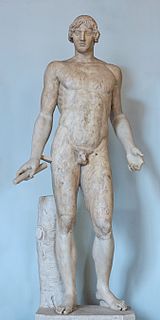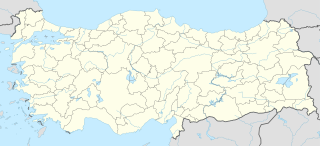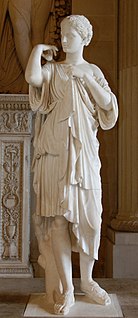
The 4th century BC started the first day of 400 BC and ended the last day of 301 BC. It is considered part of the Classical era, epoch, or historical period.
Year 335 BC was a year of the pre-Julian Roman calendar. At the time, it was known as the Year of the Consulship of Calenus and Corvus. The denomination 335 BC for this year has been used since the early medieval period, when the Anno Domini calendar era became the prevalent method in Europe for naming years.

Nicomedes I, second king of Bithynia, was the eldest son of Zipoetes I, whom he succeeded on the throne in 278 BC.

Praxiteles of Athens, the son of Cephisodotus the Elder, was the most renowned of the Attic sculptors of the 4th century BC. He was the first to sculpt the nude female form in a life-size statue. While no indubitably attributable sculpture by Praxiteles is extant, numerous copies of his works have survived; several authors, including Pliny the Elder, wrote of his works; and coins engraved with silhouettes of his various famous statuary types from the period still exist.
Year 370 BC was a year of the pre-Julian Roman calendar. At the time, it was known as the Year of the Tribunate of Capitolinus, Medullinus, Praetextatus, Cornelius, Volusus and Poplicola. The denomination 370 BC for this year has been used since the early medieval period, when the Anno Domini calendar era became the prevalent method in Europe for naming years.

The Apollo Lyceus type, also known as Lycean Apollo, originating with Praxiteles and known from many full-size statue and figurine copies as well as from 1st century BCE Athenian coinage, is a statue type of Apollo showing the god resting on a support, his right forearm touching the top of his head and his hair fixed in braids on the top of a head in a haircut typical of childhood. It is called "Lycean" not after Lycia itself, but after its identification with a lost work described, though not attributed to a sculptor, by Lucian as being on show in the Lyceum, one of the gymnasia of Athens. According to Lucian, the god leaning on a support with his bow in his left hand and his right resting on his head is shown "as if resting after long effort." Its main exemplar is the Apollino in Florence or Apollo Medici, in the Uffizi, Florence.

Scopas or Skopas was an Ancient Greek sculptor and architect most famous for his statue of Meleager, the copper statue of "Aphrodite" and the head of goddess Hygieia, daughter of Asclepius.

Calamis was a sculptor of ancient Greece. He was possibly from Boeotia, but nothing certain is known of his life although he is credited with having lived in Athens, and his sculptures are representative of Athenian sculpture. Although none of his works survives, he is known for his talent and skill in sculpting animals, especially horses, as opposed to the human body. He is known to have worked in marble, bronze, gold, and ivory, and was famed for statues of horses. According to Pausanias (9.16.1), Calamis produced a statue of Zeus Ammon for Pindar, and mentions a Hermes Criophorus for Tanagra (9.22.1), which was later depicted on Roman coins of the city. His statue of Apollo Alexikakos stood in the Ceramicus of Athens. He produced his most ambitious work, a 30-cubit statue of Apollo for Apollonia Pontica. His Sosandra was praised by Lucian, and may have been copied for Aspasia, which in turn was copied by the Romans.

Phryne was an ancient Greek courtesan (hetaira), from the fourth century BC. She is best known for her trial for impiety, where she was defended by the orator Hypereides.

Cephisodotus or Kephisodotos was a Greek sculptor, perhaps the father or an uncle of Praxiteles, one of whose sculptor sons was Cephisodotus the Younger.
Praxias and Androsthenes, Greek sculptors, who are said by Pausanias to have executed the pediments of the temple of Apollo at Delphi. Both were Athenians, Praxias a pupil of Calamis. The statement raises historic difficulties, as, according to the leaders of the recent French excavations at Delphi, the temple of Apollo was destroyed about 373 BC and rebuilt by 339 BC, a date which seems too late for the lifetime of a pupil of Calamis. In any case no fragments of the pediments of this later temple have been found, and it has been suggested that they were removed bodily to Rome.

Alexandros of Antioch was a Greek sculptor of the Hellenistic age.

Pitane, near Çandarlı, Turkey, was an ancient Greek town of the ancient region of Aeolis, in Asia Minor.
Calamis may refer to two sculptors of ancient Greece:

The Venus of Arles is a 1.94-metre-high (6.4 ft) sculpture of Venus at the Musée du Louvre. It is in Hymettus marble and dates to the end of the 1st century BC.

Apollo Sauroktonos is the title of several 1st - 2nd century AD Roman marble copies of an original by the ancient Greek sculptor Praxiteles. The statues depict a nude adolescent male about to catch a lizard climbing up a tree. Copies are included in the collections of the Louvre Museum, the Vatican Museums, and the National Museums Liverpool.

Eirene, more commonly known in English as Peace, was one of the Horae, the personification of peace. She was depicted in art as a beautiful young woman carrying a cornucopia, sceptre, and a torch or rhyton. She is said sometimes to be the daughter of Zeus and Themis and sister of Dike and Eunomia. Her Roman equivalent was Pax.

The Diana of Gabii is a statue of a woman in drapery which probably represents the goddess Artemis and is traditionally attributed to the sculptor Praxiteles. It became part of the Borghese collection and is now conserved in the Louvre with the inventory number Ma 529.

The Dancers of Delphi, also known as the Acanthus Column, are three figures in high relief on top of an acanthus column found near the sanctuary of Pythian Apollo at Delphi. They are on display in the Delphi Archaeological Museum and were the inspiration for the first of Claude Debussy's Préludes.














